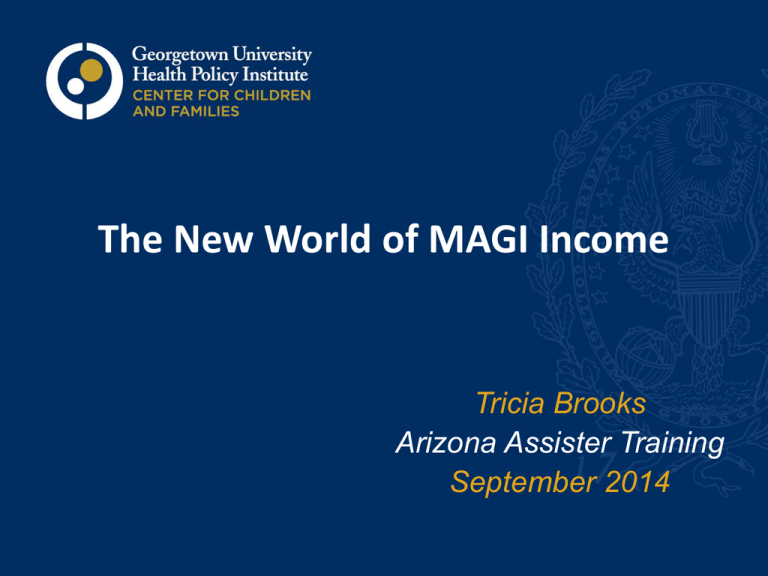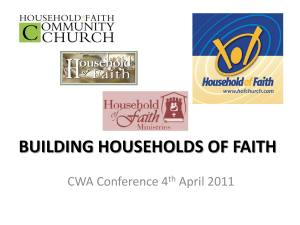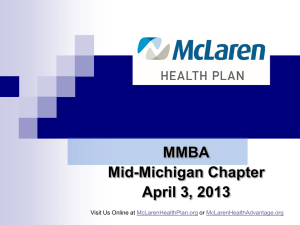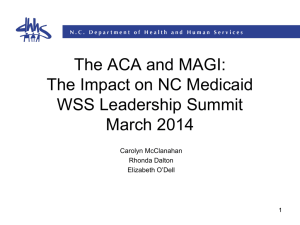AZ-MAGI - Cover Arizona
advertisement

The New World of MAGI Income Tricia Brooks Arizona Assister Training September 2014 Warning! o This training gets into the policy weeds of how household and income are counted under MAGI! 2 What is MAGI-based eligibility? • Modified Adjusted Gross Income - Not a number; it’s a methodology for determining eligibility - Determines who’s counted in the household and whose income counts toward eligibility • Rooted in tax law • Replaced prior Medicaid income, disregards and household counting rules as of January 1, 2014 3 Why new rules? • • • Eliminate potential gaps between coverage options by aligning eligibility for premium tax credits (PTCs) with Medicaid Simplify the eligibility process and provide consistent rules across states Move toward real time eligibility with reliance on electronic data sources 4 Which groups are subject to MAGI? Children Parents and caretaker relatives Pregnant women People with disabilities and seniors needing long term care Newly eligible adults (aka Medicaid expansion) 5 Medicaid/ Arizona AHCCCS Eligibility States were required to convert old standards to new MAGI rules. MAGI moves toward electronic, real-time eligibility determination. Income Limit Eligibility Criteria Verification Children < 1 year 152% FPL Electronic * Children 1 – 5 146% FPL Citizenship/Immigr ation Status Children 6 - 18 138% FPL Income Electronic * Pregnant Women 161% FPL Age/DOB Self-Attestation ** Adults 138% FPL Household Self-Attestation ** SSN Electronic * Pregnancy Self Attestation ** State Residency Electronic * * If cannot be verified electronically, paper documentation required. ** If discrepancy between electronic sources, paper documentation required. 6 Three Steps for Assessing Eligibility • Determine if non-filer, tax-filer, taxStep 1 dependent, or exception for Medicaid • Determine household size based on Step 2 applicable tax-filer, non-filer or exception rules • Add the MAGI income of all the relevant Step 3 members of the individual’s household. 7 Step 1 • • • • • • • Key Points about Household Size Rules are different for tax-filers and non-filers. Only tax-filers are eligible for PTCs/CSRs, and married couples must file jointly. Tax-filer rules apply to both PTCs/CSRs and Medicaid. Non-filer rules apply only to Medicaid. There are 5 exceptions for tax filers or tax dependents; non-filer rules apply to Medicaid in these situations. Household size may be different for different members of the family, and different for Marketplace vs. Medicaid. 8 Tax Filers: Household Composition • Household = all individuals in the tax filing unit - Tax-filer - Spouse - Tax dependents • • Qualifying child Qualified relatives - Exclude “not lawfully present” in the household 9 Non-Filers: Household Composition General Rule: Household = all individuals living together who are related (more like old Medicaid rules) Children Adults – Adult – Spouse – Children under 19 • Biological, adopted or step – Would not include qualified relatives – Child – Child’s parents (including step-parents) – Children’s siblings • Biological, adopted or step – Child’s spouse if married and living with the child. – The child’s children, if living with the child. 10 Exceptions to tax-filer rules for Medicaid: Non-filer rules apply in these situations ① ② ③ ④ ⑤ Child claimed on non-custodial parent taxes Child living with unmarried parents or parents filing separate tax returns Any tax dependent (child or qualified relative) claimed by someone other than a parent or spouse Married couples living together filing separately Pregnant women 11 ① Child (under 19) claimed as tax dependent by non-custodial parent • Medicaid eligibility for the child only is based on the custodial parent’s household. • For premium tax credits, the child’s eligibility is based on the income of the parent who claims the child. 12 Example Exception 1 – Alan, Judith and Jake Alan and Judith are divorced and both file taxes. They have a son, Jake, who lives with Alan, but is claimed by Judith on her tax return. Marketplace Household Medicaid Household Alan Household of 1, Alan Household 1, Alan Jake Household of 2, Judith and Jake Household of 2, Alan and Jake Judith Household of 2, Judith and Jake Household of 2, Judith and Jake 13 ② Child living with both parents who are unmarried or file taxes separately • Both parents are included in the child’s household for Medicaid • For PTCs, the child’s eligibility is based on the tax filing parent’s household and income if the parents are unmarried • If married filing separately, the family is not eligible for PTC 14 Example Exception 2– Ross and Rachel Ross and Rachel are not married, and file separate tax returns. They live together with their daughter, Emma. Ross claims Emma on his tax return. Marketplace Household Medicaid Household Ross Household of 2, Ross and Emma Household of 2, Ross and Emma Emma Household of 2, Ross and Emma Household of 3, Ross, Rachel and Emma Rachel Household of 1, Rachel Household of 1, Rachel 15 ③ Individual claimed as tax dependent by someone other than a parent or spouse • Qualifying child - For example, child living with a grandparent • Other qualifying relative - For example, grandmother living with son’s family • For Medicaid, use nonfiler rules for that person only 16 Example Tax Dependent – Will Smith/Banks Will Smith lives with his Uncle Phillip’s family. The Banks have 3 biological children. Will is claimed as a tax dependent on the Banks’ tax return, in addition to the other 5 members of the family. Marketplace Household Medicaid Household Will Household of 6, Will and all 5 Banks Household of 1, Will Banks Family Members Household of 6, Will and all 5 Banks Household of 6, Will and all 5 Banks 17 ④ Married couples living together but filing taxes separately • • For Medicaid, married couples living together are included in each other’s household regardless of whether they are tax-filers or non-filers Married couples must file jointly to qualify for PTCs Marketplace Household Medicaid Household Lucy Not eligible, not filing jointly Household of 2 Ricky Not eligible, not filing jointly Household of 2 18 ⑤ Pregnant Women • For Medicaid, the pregnant woman’s household includes the the number of babies expected • However, for other family members, Arizona only counts the pregnant woman as one person • If the pregnant woman files taxes or is a tax dependent, tax-filer rules apply, you just increase the household size for the number of babies in determining her eligibility 19 Ross and Rachel are having another baby Ross and Rachel are not married. They live together and have one child, Emma, and Rachel is pregnant. Ross claims Emma on his taxes and Rachel files separately. Marketplace Household Medicaid Household Ross Household of 2, Ross and Emma Household of 2, Ross and Emma Emma Household of 2, Ross and Emma Household of 3, Ross, Rachel and Emma Rachel Household of 1, Rachel Household of 2, Rachel plus baby 20 Step 2A • Who’s income counts? Generally, the MAGI income of all individuals must be counted toward household income Income of tax dependents is NOT included if they are not EXPECTED to file taxes. The filing threshold for children for 2014 is $6,100 for earned income, $1,000 for unearned income; for other tax dependents, it’s $3,950 21 Step 2B • What income counts? Adjusted Gross Income from line 31 on 1040 + Excluded foreign income + Tax exempt interest + Non-taxable Social Security benefits Taxable Income Sources = MAGI Adjustments to Income Adjusted Gross Income (AGI) 22 What income counts? • • • • • • • • Counted Wages and tips Unemployment Pensions and annuities Net business/farm income Dividends and taxable interest Alimony received Rents and royalties received Social Security retirement or survivor benefits (both taxable and non-taxable) Not Counted • TANF • SSI (disability) • Child support • Gifts • Qualified scholarship (for tuition only) 23 What deductions/adjustments count? Most common: • Alimony paid • Student interest • IRA contribution • Moving expenses • Other deductions are listed (lines 2335 on 1040) 24 Changes to How Income is Counted in Medicaid INCOME SOURCE PRE-MAGI MEDICAID MAGI MEDICAID Self-employment Not all business expenses (i.e. depreciation) were deductible NET INCOME/PROFIT Counted with all tax deductible expenses and business losses (line 31 of schedule C or line 34 from schedule F) Pre-tax deductions or salary deferrals (flex spending accounts, childcare, 401(k)) Included in gross income Not included in gross income Child support received Counted as income Not counted as income Alimony paid Not deducted from income Deducted from income Veterans’ benefits Counted as income Not counted as income Workers’ compensation Counted as income Not counted as income Step-parent income State option but not always counted toward child’s eligibility Counted as household income TANF and SSI Counted as income Not counted as income 25 Differences in how income is calculated for Medicaid that do not apply to PTCs/CSRs • • For new applicants, Medicaid looks at “current monthly income” • Scholarships and other education awards not counted • Native American income does not count • Lump sum payments counted only in month received PTC eligibility is based on “projected annual income” for applicable tax year 26 Deduct pre-tax contributions/salary deferrals when reporting income Certain employee contribution to benefits that are deducted from wages before federal taxes are calculated. Taxes are calculated on the reduced wage and are therefore lower. Common pre-tax contributions Dependent Care Medical Flex Spending Accounts 401(k) or 403(b) Retirement Accounts 27 How to identify pre-tax deductions? On Pay Stubs: Difference between gross wages and gross “taxable” wages. Or list of deductions taken. 28 Examples – Pre-tax Deductions Example 1 Mary is a single Mom with a 2-year daughter. She earns $1,900 per month (144% FPL) and receives $500 per month in child support. She also has $200 per week taken out for child-care. • Is Mary eligible for AHCCCS? Example 2 John is a single male. He earns $45,000 per year but contributes $5,000 to his retirement account. •What is John’s income based on MAGI? Example 3 John is single and earns $17,000 (146% FPL). The company he works for doesn’t have a retirement account but he deposits $100 each month into an IRA •What is John’s income based on MAGI? •Is John eligible for AHCCCS? 29 How about Social Security income? For adults… For children… • All social security benefits (not SSI) whether taxable or not count toward MAGI • When a child is claimed as a tax dependent by someone other than a parent or spouse, the child’s survivor benefits and SSDI count toward household income only if the child has other income that requires them to file taxes. • If child is in own household, (i.e. Medicaid exceptions) all of his/her income counts toward his/her eligibility ⁻ Social security retirement ⁻ Social security survivor benefits ⁻ Social security disability income (SSDI) ⁻ Could mean adult who is not required to file taxes, is over Medicaid income threshold, and would need to file taxes to get PTCs 30 Social Security Income Examples Example 1 Mary earns $800 per month (82% FPL) working part-time and receives $600 per month (combined 144% FPL) in social security survivor benefits. She does not file taxes. • Is Mary eligible for AHCCCS? • What about PTCs? Example 2 Same scenario but Mary has a 17-year old daughter. Her MAGI of $1,400 = 106% FPL for family of 2. Jane, who also receives $600 per month in social security survivor benefits. Jane does not earn any income and does not file taxes. •Does Jane’s SS count? Example 3 Same scenario as Example 2. But Jane also earns $600 per month working parttime after school. Jane’s earned income and SS benefits, plus Mary’s total income = 198% FPL. •Is Mary eligible for AHCCCS? •What about Jane? 31 Georgetown McCourt School of Public Policy Health Policy Institute Center for Children and Families Center on Health Insurance Reforms Tricia Brooks JoAnn Volk Tricia.Brooks@georgetown.edu Joann.Volk@georgetown.edu Website: http://ccf.georgetown.edu/ Website: http://chir.georgetown.edu/ Say Ahhh! a child health policy blog: http://ccf.georgetown.edu/bl og/ CHIR Blog: http://chirblog.org/ 32







